Effect of Low- frequency Electromagnetic Field on the Properties of Wheat and Barley Seeds
Effect of Low- frequency Electromagnetic Field on the Properties of Wheat and Barley Seeds
Abstract
The article examines the nature of the influence of the electromagnetic field of low-frequency radiation on the germination and germination energy of seeds of various varieties of spring wheat and barley. It is shown that as a result of the influence of low-frequency electromagnetic field in spring wheat seeds, laboratory and field germination of seeds increases. Moreover, the level of stimulation depends on the duration of seed irradiation. The maximum growth of germination is observed at presowing treatment during 10-30 minutes. Further increase of exposure time leads to a decrease in germination. In barley, the effect of magnetic field differs from the nature of the effect on wheat seeds. At irradiation from 10 to 30 min germination decreases, at longer irradiation there is a tendency to its increase. Using a mathematical model linking the water content in seed cells, their swellability in water and irradiation time showed a correlation between the water content in the seed and the effect of EMF exposure on seed germination.
1. Introduction
Recently, among biologists, physicists, and chemists engaged in studies of the effects of exposure to various energy sources on living organisms and biological systems, interest in the nature of the effects of electromagnetic fields has increased , , , . The development of research in the field of magnetobiological effects has been widespread in industry, medicine, and agriculture; however, contradictory results of both positive and negative nature have been obtained for practical application, which significantly expands the problems of using magnetobiological effects.
The differences in the obtained effects are caused, on the one hand, by different responses of biosystems to the effects of radiation of different nature, due to different mechanisms of physical phenomena that are realized in the irradiated plant. On the other hand, this is due to a variety of factors determining the nature of changes in biochemical photochemical and oxidative processes occurring in the plant under the action of metabolism, which has a complex character. The quality of seed material and environmental conditions play a significant role in biomass accumulation .
Nevertheless, to date, numerous technologies have been developed that use sources of magnetic fields and radiation of different nature for pre-sowing treatment of plant seeds to stimulate their growth and development, increase yield and improve the consumer qualities of the resulting grain. When using these technologies, the dependence of the nature, intensity, and dose of irradiation on the energy effect of the irradiation source is revealed . It is an important technological task to evaluate the influence of wheat seed treatment with low-frequency electromagnetic field on yield in an industrial unit under field conditions. At the same time, the actual problem is the establishment of the peculiarities of the mechanism and factors of electromagnetic field impact on plant life activity, which is a necessary condition for ensuring high efficiency of this technology application. On the other hand, such an approach to analyzing the conditions of manifestation of the magneto effect, allows to create the design of technological equipment, technological methods, modes and conditions of plant seed treatment, ensuring the achievement of high results.
The purpose of the work is to study the peculiarities of the influence of electromagnetic field of low-frequency radiation on the efficiency of growth and development of agricultural seeds. It is important to investigate the applicability of the model, with the help of which it is possible to carry out a study of cause-effect relationships from the EMF impact on seeds in order to predict MBE.
2. Materials and methods
The work is aimed at studying the magnetobiological effect of exposure to electromagnetic field of low-frequency radiation on seeds of grain crops, their biochemical and morphophysiological parameters with the help of magnetobiological apparatus "Polimag". The seeds of spring wheat varieties "Ivolga" and "Omskaya-18", spring soft wheat variety "Maestro", winter wheat variety "Moskovskaya 39" and spring barley variety "Znatny" were used for the study. All seeds were treated in the mode of magnetic induction B = 10 mTl and radiation frequency f = 16 Hz, varying the treatment time from 10, 20, 30, 40 and 60 min. and the mass of treated seeds from 10 to 250 grams, laid in layers with a height of 3 to 150 mm. Irradiation was carried out at 20о C in an air environment. After irradiation, seeds were kept in dark mode at 20-22о C for 2 weeks to achieve equilibrium state by cellular structures after stress (according to GOST 12038-84). The influence of EMF treatment conditions on germination energy and germination of seeds was studied in laboratory conditions in Petri dishes according to GOST 12038-84 placed in a thermo-cabinet in the dark for up to 12 days. Seeds were also germinated in soil in the dark. Repetition of samples was not less than 3. Each sample included 50 or 100 seeds each. For laboratory tests, seeds were placed in one layer on filter paper (filter paper of "Blue Ribbon" brand, FM batch, filter diameter 125 mm, mass of ash of 1 filter 0.00090 g.) and poured with water until they were completely covered. Germination energy was determined on the third and fifth days, germination - on the 8th day after sowing. Biometric parameters were measured on the 5th-10th day. Experimental data were processed using dispersion and correlation analysis using the program "AGROS -2.02".
Mathematical models were used to account for the factors of energy influence on the biological processes occurring in wheat and barley seeds. These models are based on the following laws: under the influence of a magnetic field on seeds, the rate of chemical reactions (enzymatic hydrolysis) in seed cells increases, which can be represented by the following expression :
where ω is the rate of chemical reaction without magnetic field, mol/l∙s;
μ – reduced mass of particles, kg;
B – magnetic induction, Tl;
v – particle velocity, m/s;
K – coefficient, which depends on the concentration and type of ions, as well as the number of remagnetizations, m/s∙∙Tl;
Na is Avogadro's number, molecules/mol;
R is the universal gas constant, J/mol∙K;
T is the temperature,
Since the action of magnetic field on the cell inside the seed accelerates the transport of water to the embryo, the diffusion of water molecules changes the concentration of mineral solution. Water takes part in the chemical reaction of hydrolysis of carbohydrates in the endosperm, initiating the development of the embryo. The change in the reaction rate under the action of magnetic field is due to the effect of the field on the diffusion of water molecules through the cell membrane. At the initial moment of time, the amount of substance in the solutions separated by the membrane is C1 V and C2 V, respectively. In the steady-state regime after diffusion of water molecules from the solution with a lower concentration into the solution with a higher concentration of substance, the concentrations of solutions are equalized and make up
where ΔV is the volume of water that has passed through the membrane, m3.
Molecules of the cell membrane, according to modern ideas about its structure, are dipoles. It is known that a force acts on a magnetic dipole placed in a magnetic field:
where M is the magnetic moment of the dipole, J/Tl, V is the magnetic induction, Tl.
This force causes the cell membrane to deform.
According to Hooke's law, absolute strain:
where kг is the stiffness (elasticity) coefficient of the membrane, N/m; X is the absolute deformation, m.
The value of absolute membrane strain:
The size of the pore in the membrane under the action of the magnetic field will increase and will amount to
This means that the action of a magnetic field on the cell membrane increases its permeability.
Then the amount of substance that has passed by diffusion through the membrane will be determined by the equation:
where R is the universal gas constant, J/molK;
T – temperature, K;
μ – reduced mass of particles, kg;
B – magnetic induction, Tl;
v – particle velocity, m/s;
k – coefficient, which depends on the concentration and type of ions, m/s∙Tl;
С1 – water concentration before magnetic treatment, mol/L;
С2 – water concentration after magnetic treatment, mol/L.
L – is the path that the treated substance passes in the magnetic field, m.
Thus, under the action of the magnetic field on the cell due to the intensification of the water diffusion process, the chemical reaction rate and the concentration of reaction products change according to equation (1), which in a simplified form links the parameters of the magnetic field and the structure of cell membranes. Equation (1) allows us to establish the dependence of the value of ΔC on the irradiation time t (ΔC = f (t)). The ratio of water concentration in irradiated to non-irradiated seeds ΔС1*/ΔС*2 allow us to describe the dependence of the rate of chemical and biochemical reactions occurring in seeds on the magnetic field parameters and to identify the optimal modes of magnetic treatment of seeds of cultivated plants.
3. Results and discussion
The work is aimed at studying the effect of the electromagnetic field of low-frequency radiation on germination and germination of cereal seeds. In this work we took into account that the MBE is caused by the influence of electromagnetic field on the peculiarities of physical, chemical and biochemical processes in the cellular structures of wheat and barley seeds at the stage of ontogenesis and germination. Experimental studies were carried out in two stages. The first stage is devoted to the determination of germination energy and germination of irradiated and non-irradiated seeds, determination of biometric indices of morphological organs of seedlings: stem and leaf weight, length and weight of the root system, establishment of the influence of weight and thickness of the layer and mode of seed treatment. The second stage is devoted to assessing the applicability of the mathematical model that establishes causal relationships between the energy parameters of this impact and the characteristics of seeds.
Since an important aspect of the problem of effective EMF operation in industrial equipment is the conditions of its operation, at the first stage of the work we established the factors determining the relationship of low-frequency EMF EME on germination and seed germination of all selected samples of cultivated plants. First of all, the dependences of the parameters of wheat plants grown from magnetized seeds on the modes and time of their exposure were established. The grain was treated with a magnetic field with magnetic induction (B) = 10 mTl, at a frequency of 16 Hz in the conditions of a stationary grain mass. The time of magnetic field exposure was varied from 5 to 60 min, and the mass of treated seeds was varied in the range of 10-250 grams.
Parameters characterizing the influence of low-frequency EMF on the germination rate of spring wheat seed samples of different varieties and spring barley samples treated in different modes for different times, grown on substrates in laboratory conditions, are presented in Table 1.
Table 1 shows the dependence of changes in the values of germination energy and seed germination as a result of treatment with low-frequency EMF on the weight of treated seeds. As can be seen irradiation of seeds causes 1) growth of germination parameters of spring wheat, variety "Ivolga" when irradiated for 10 min: seed weight 10 grams to 15.6% at irradiation of 50 grams mass – up to 14,8%; 250 grams – up to 10,7%; at irradiation within 30 min of seed mass 10 grams – up to 15,6% at irradiation of 50 grams mass – up to 16,0%; 250 grams – up to 10,7%; at irradiation of seed mass within 60 min for 10 grams germination increase reaches 19,5% at irradiation of 50 grams mass – up to 16,0%; 250 grams – up to 14,5 %. 2) growth of germination energy parameters of spring wheat, variety "Ivolga", reaches at irradiation within 10 min: seed weight 10 grams up to 14,3% at irradiation of weight 50 grams – up to 12,4%; 250 grams – up to 9,6%. At irradiation within 30 min of seed mass 10 grams up to 28,5% at irradiation of mass 50 grams – up to 16,5%; 250 grams – up to 9,6% At irradiation of seed mass within 60 min for 10 grams increase of germination up to 22,9% at irradiation of mass 50 grams – up to 13,7%; 250 grams – up to 13,6%. Thus the difference between the parameters of germination energy and germination of samples of different masses of seeds irradiated for different times between small and large masses leveled off with increasing treatment time. Obviously, this is due to the `larger time required for the radiation source to irradiate a large mass of seeds uniformly.
Comparison of data obtained in laboratory conditions (Fig. 1-4) showed that EMF exposure of wheat seeds of different varieties, in the interval of 5-40 minutes of irradiation leads to an increase in germination energy and germination of seeds. At the same time, treatment of barley seeds decreases the germination index. Analysis of changes in seed germination and seedling height (Fig. 1-8) during their growth showed that there is a tendency to equalization of indicators in irradiated and non-irradiated seeds of both wheat (Fig.1,2) and barley (Fig.2-4) with increasing time of seed growth and development (Fig.4-8).
Table 1 - Germination energy and germinability of spring wheat seeds, variety "Ivolga", exposed to electromagnetic low-intensity magnetic field
Measured parameters | Control | Processing time, min | |||
10 | 30 | 60 | |||
Seed germination energy, average values, % | seed lot 1 (10 grams) | 70.0 | 80.0 | 90.0 | 86.0 |
seed lot 2 (50 grams) | 78.3 | 88.0 | 91.0 | 89.0 | |
seed lot 3 (250 grams) | 75.7 | 83.0 | 83.0 | 83.0 | |
Seed germination, average values, % | seed lot 1 (10 grams) | 77.0 | 89.0 | 89.0 | 89.0 |
seed lot 2 (50 grams) | 79.3 | 91.0 | 92.0 | 92.0 | |
seed lot 3 (250 grams) | 77.7 | 86.0 | 86.0 | 89.0 | |
Deviation from control, % | |||||
For seed germination energy | seed lot 1(10 grams) | - | 14.3 | 28.5 | 22.9 |
seed lot 2 (50 grams) | - | 12.4 | 16.2 | 13.7 | |
seed lot 3 (250 grams) | - | 9.6 | 9.6 | 13.6 | |
For germination | seed lot 1 (10 grams) | - | 15.6 | 15.6 | 19.5 |
seed lot 2 (50 grams) | - | 14.8 | 16.0 | 16.0 | |
seed lot 3 (250 grams) | - | 10.7 | 10.7 | 14.5 | |
Note: 10mTl, 16 Hz; the error in parameterization is ±1
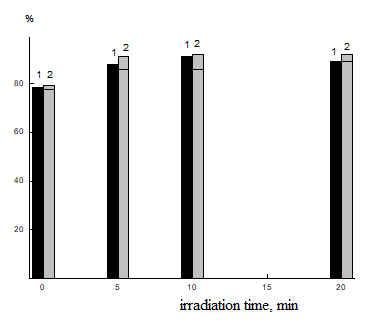
Figure 1 - Dependences of germination energy (1) and germination capacity (2) of spring wheat seeds of Omskaya-18 variety on the time of irradiation with electromagnetic field of low-frequency EMI
Note: 10 mTl, 16 Hz; laboratory experiment
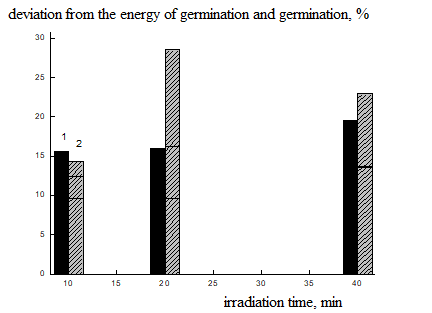
Figure 2 - Dependence of germination energy deviation (1) and germination (2) of spring wheat Ivolga seeds from the unirradiated sample (control) on the time of irradiation with EMF LF EMI
Note: laboratory experiment
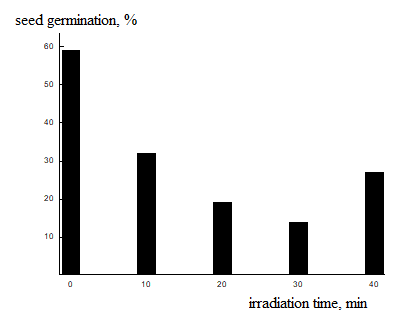
Figure 3 - Dependence of germination of spring barley seeds "Znatny" on irradiation time at 4 days of germination
Note: laboratory experiment
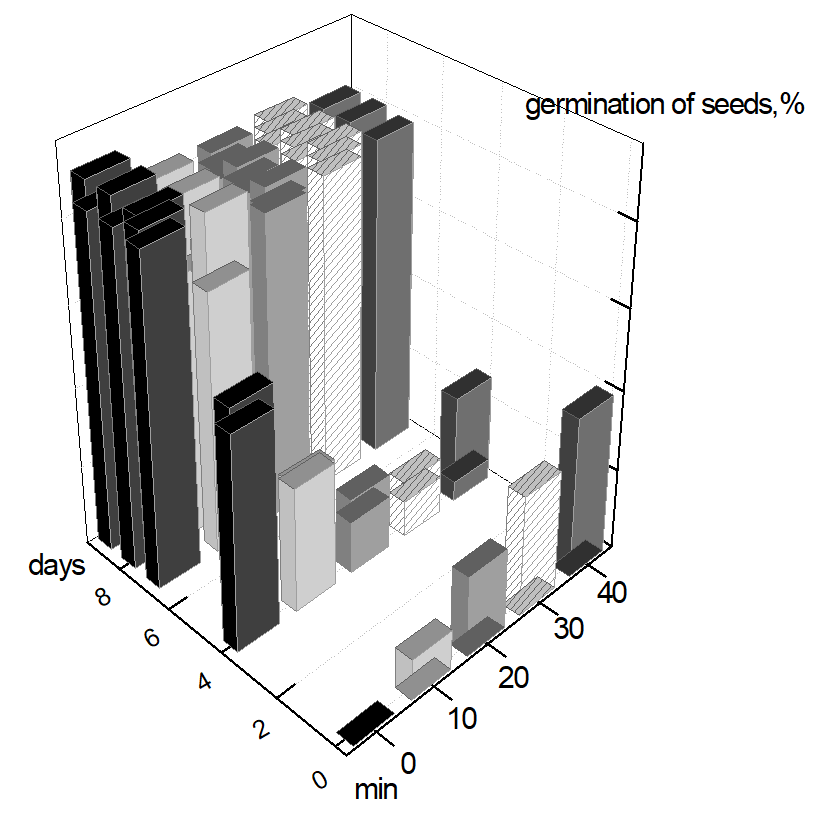
Figure 4 - Dependence of germination of spring barley seeds "Znatny" pre-irradiated 0 (1), 10 (2), 20 (3), 30 (4) and 40 minutes (5) from the duration of their germination
Note: laboratory experiment
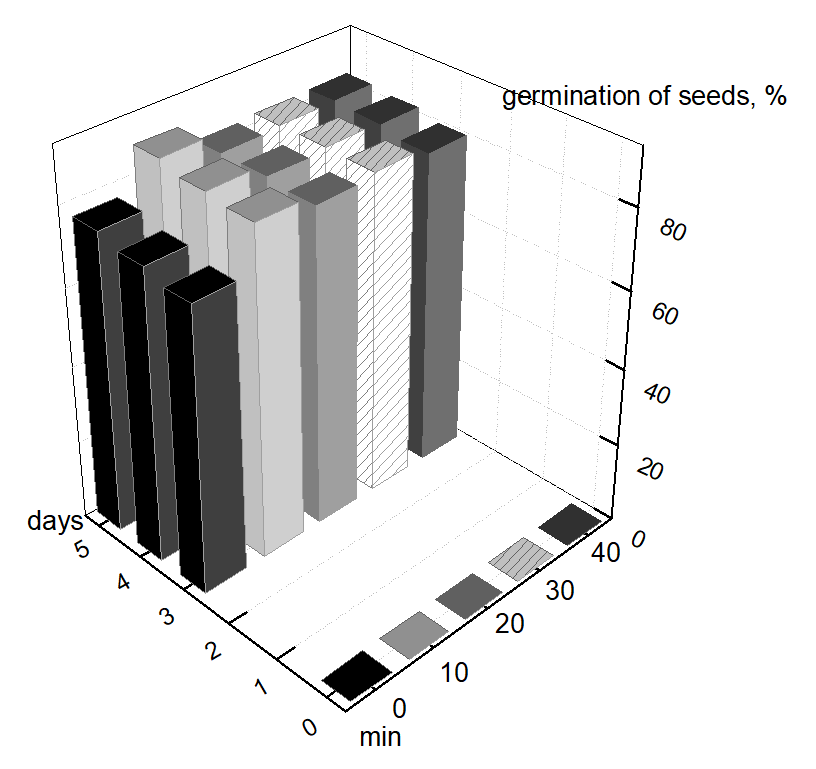
Figure 5 - Dependence of germination of seeds of spring soft wheat "Maestro" super elite, for control (1) and samples subjected to pre-sowing exposure to EMF LF EMI (10 mTl, 16 Hz) for 10 , 20 , 30 and 40 minutes on the time of growing seeds in the soil

Figure 6 - Dependence of sprout height of spring barley soft wheat "Maestro" super elite, subjected to pre-sowing exposure to electromagnetic low-frequency field for 0, 10 , 20 , 30 and 40 minutes on the germination time in the soil
Note: the number of seeds of 100 each in the experiment
In barley, seed treatment leads to a decrease in germination and sprout size (germination rate) due to irradiation (Fig.7,8). The sprout size of the irradiated sample with increasing germination time approaches the control (non-irradiated).
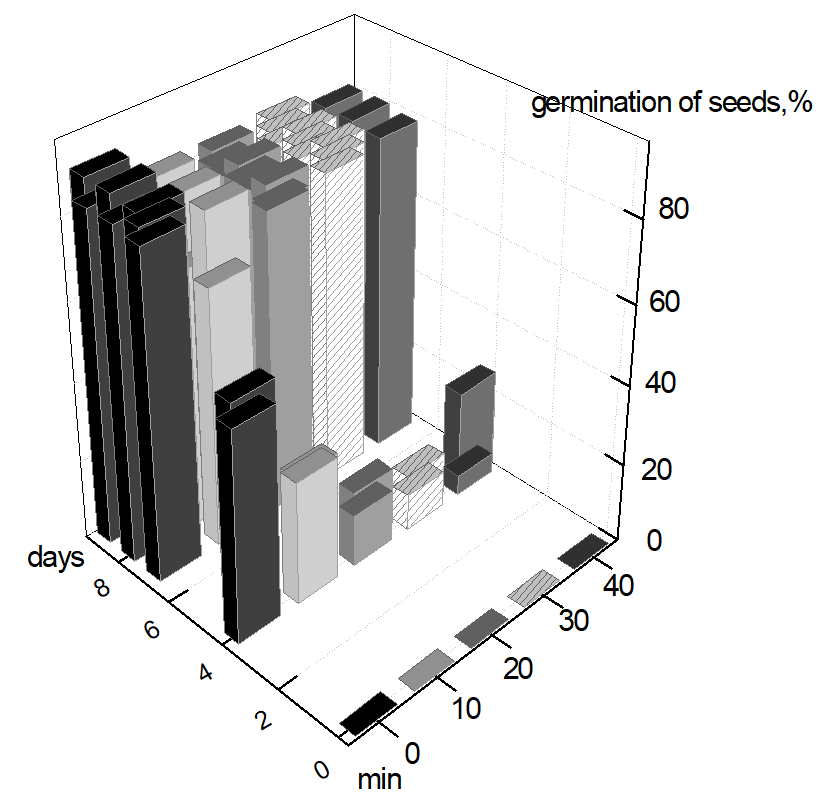
Figure 7 - Dependence of germination of spring barley "Znatny" super elite seeds subjected to pre-sowing exposure to EMF low frequency (10 mT, 16 Hz) during 0 , 10 , 20 , 30 and 40 minutes on the time of germination of plants in soil. Number of seeds: 100 seeds per experiment
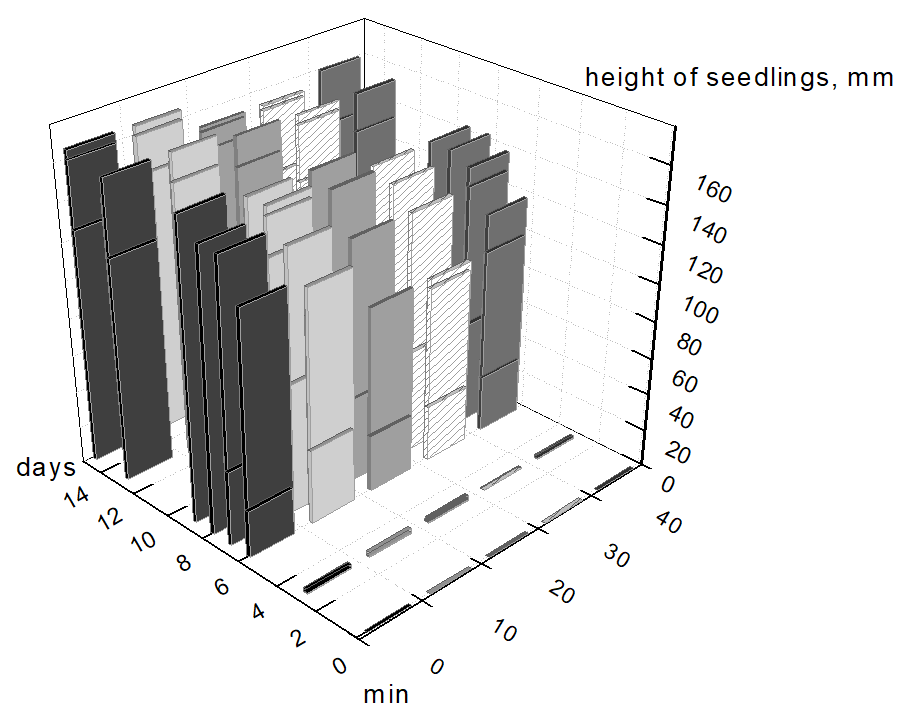
Figure 8 - Dependence of sprout height of spring barley "Znatny" subjected to pre-sowing exposure to electromagnetic low-frequency field (10 mTl, 16 Hz) 0, 10, 20, 30 and 40 minutes on the germination time in the soil
Note: the number of seeds of 100 pcs
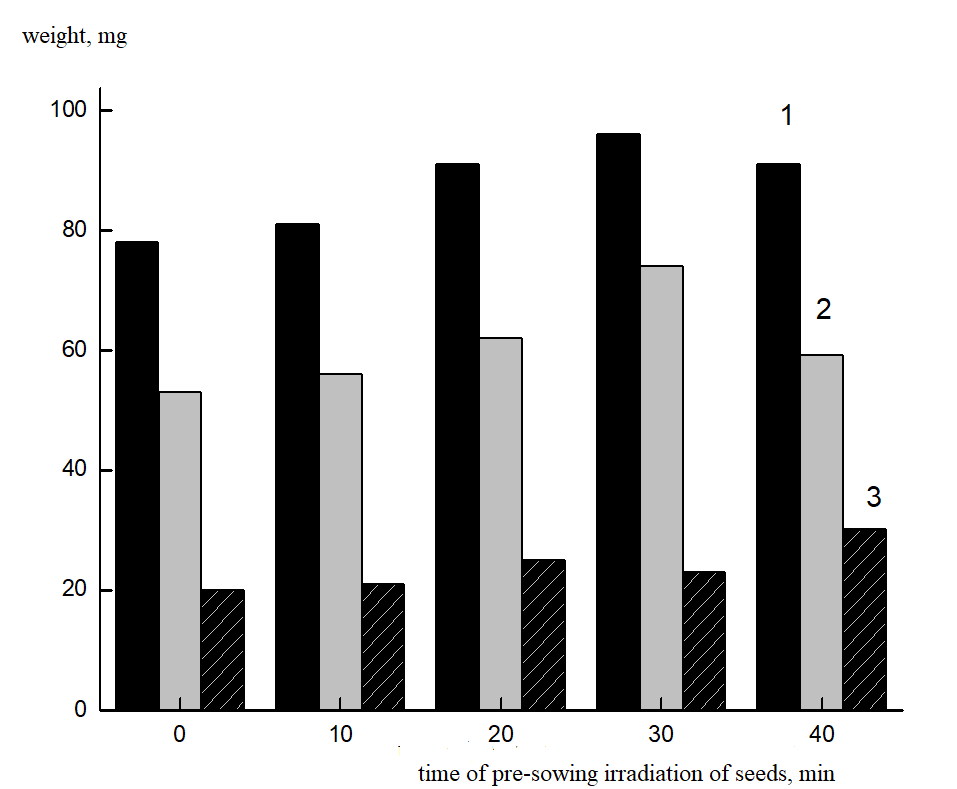
Figure 9 - Dependence of plant (1), stem (2) and root (3) weight of barley subjected to pre-sowing exposure to electromagnetic low-frequency field (10 mTl, 16 Hz) on irradiation time. The given data were obtained for seeds germinated in soil for 14 days
Note: 100 pcs; the error of the experiment is ±1 mg
Thus, if the treatment of wheat seeds with electromagnetic field for 10-20 minutes causes an increase in productivity parameters at the tillering stage by 12-25%.
Treatment of barley seeds with low-frequency EMF suppresses seed germination at treatment from 10 to 40 minutes. Longer irradiation can lead to an increase in the activity of seed germination and the intensity of the root system growth may change.
It is important to note that the realization of potential abilities of barley seeds caused by EMF irradiation increased as the plants grew. According to the diagnostic data on the 14th day of seed germination we can state the increase in root growth in seedlings grown from irradiated seeds for 40 minutes.
It is known that the same seeds sown on filter paper and in soil germinate differently. As a rule, they germinate worse in soil than on paper, because in soil they are sometimes negatively affected by microorganisms, acidity, humidity, temperature and other environmental factors. There are cases when seeds germinate noticeably better in soil than in the laboratory , . While laboratory germination shows the percentage of germinated seeds, field germination is the percentage of sprouts from the number of germinated seeds sown. This indicator plays a major role in the formation of yield: thinned crops cannot provide a high yield. The value of field germination depends on many reasons: sowing qualities of seeds, the quality of preparation of the sowing layer of soil and its moistening, the quality of sowing.
An important question is why the treatment of spring wheat and barley seeds with low-frequency EMF causes a different response, and what this is due to. It can be assumed that the peculiarities of the effect of irradiation with electromagnetic field of low-frequency EMI on the parameters of germination and seedling development of wheat and barley seeds may be due to the composition and structure of mineral substances included in their grains and have different types of germination mechanisms. As it is known seed germination is accompanied by intensive changes in metabolism in physiological and biochemical processes. Obviously, these factors determine the peculiarities of influence of low frequency EMF on wheat and barley seeds. The study of fundamental aspects of seed germination in irradiated and non-irradiated states allows us to determine these features.
To understand this issue, let us consider the behavior of seeds of the above crops in different microphenological phases of their development. For this purpose, we used the methodology proposed for barley seeds by the authors of .
Table 2 - Results of EMF low-frequency impact on wheat and barley seeds
Plant species, variety | Experiment variant | Number of seeds on 3 days | % of germinated | ||
6 days | 7 days | 8 days | |||
Spring wheat Maestro | Control | 0 | 72 | 82 | 88 |
EMF 20 min. | 36 | 87 | 89 | 91 | |
EMF 40 min. | 30 | 95 | 95 | 95 | |
Spring barley | Control | 53 | 82 | 83 | 88 |
EMF 20 min. | 13 | 70 | 76 | 78 | |
EMF 40 min. | 5 | 64 | 80 | 81 | |
As can be seen Table 2 reveals differences in the influence of EMF LF EMI on wheat and barley seeds from the position of the effects of different micro-phenological phases of seed germination. In wheat 78% of all seeds germinated on the 6th day reaching the limit value of 88% on the 8th day, and in barley after 3 days 53% of seeds germinated and after 6 days - 82% reaching the limit value on the 8th day also equal to 88%. That is, the initial degree of germination of barley is higher than that of wheat. This difference is associated with the time of onset and duration of the phase of seed germination from the moment of pecking and appearance of the embryo root in the seed to the emergence of the germ. The difference in the time of emergence of wheat seedlings compared to barley means a delay in the emergence of germinal roots from the seed coat at the achieved moisture content. It is known that in wheat the moisture content required to reach the phase from germinal spine to sprout is up to 50%. In barley seeds the increase in humidity by 12% corresponds to the period of intensive growth of the germ bud root system and active hydrolysis of stored endosperm substances. In barley, a full-fledged sprout has 5-7 roots. Sprout formation occurs through many stages of morphological changes. Apparently, the observed differences in EMF influence are related to the peculiarities of seed moisture saturation.
On the other hand, the growth of the embryo in the grain begins with the stretching of its cells and is accompanied by a change in the structure of membranes, which in dry seed are not detectable, but in germinating seed are clearly distinguishable by the appearance of new organelles. After 24 hours, mitochondria fission occurs, their number rapidly increases. Then cell divisions and differentiation begin. DNA synthesis is necessary for cell divisions to begin. It is known that in germinating seeds it starts later than protein and RNA synthesis. Further growth of the embryo occurs differently in different plants and depends on the type of germination. The water content of the grain is of great importance. The role of the main part of the cell - protoplasm in the water regime is reduced to passive permeation of water. The main indicator is permeability to water as a property of the membrane, determined by the peculiarities of the osmotic process. Intracellular water, ordering of water structure, in its turn depend on the structure of highly polymeric components of protoplasm. Possibly, the ordering of water structure under the influence of dissolved substances is hydration. Hydration of highly polymeric components changes the structure of protoplasm. Thus, the effect of electromagnetic field leads to the fact that the growth of embryo and seedling is even more dependent on the water regime of the plant and water absorption by the root.
4. Evaluation of the mathematical model describing the influence of electromagnetic field on seed parameters during pre-sowing treatment
A mathematical model of a process should both expand the area of its analytical study and create a scientific basis for solving applied problems. Obviously, the practice of engineering calculations and analytical studies impose different requirements to it. They should be taken into account when choosing the type of model, being essentially a criterion for either their selection from the available varieties or a restriction on the choice of models , , .
Heat and mass transfer in a layer of material is a complex process and, despite a significant number of studies, the problem of its mathematical description has not been finally solved to date. Therefore, it seems relevant to analyze and select rational ways to develop appropriate models.
The used methods of mathematical modeling can be divided into three classes - analytical, statistical and combined. The first one includes works based on the solution of the internal heat and mass transfer problem investigated by A.V. Lykov and his school .
The possibilities of realization and use of analytical and numerical methods for solving nonlinear transport equations, especially in the formulation of coupled problems, are known to be limited. Specific relations necessary for modeling and quantitative determinations of drying intensity, information on the kinetic characteristics of the process, are established with the involvement of experimental data. This situation is connected not only with mathematical difficulties of analysis, but also with insufficiently detailed study of the mechanism of transfer during drying. This is especially true for information on internal mass transfer.
For colloidal-capillary porous materials, the size, shape and orientation of pores relative to the particle surface play an essential role. The form of bonding of absorbed moisture with the substance of the body itself has a major influence on the mechanism of heat and moisture transfer within the body, as well as on the drying technology.
Taking this factor into account when obtaining quantitative dependencies is very complicated and insufficiently developed.
The use of analytical methods for modeling the drying of real materials is further complicated by the fact that the intensity of heat and mass transfer is largely determined by the configuration of the body surface.
Proceeding from the above stated, it is expedient for mathematical modeling of oscillating drying as an object with distributed parameters for the purpose of engineering calculations and optimization of its modes to search for unconventional approaches to the creation of mathematical models of combined type, and transfer processes to consider using integral values of its characteristics.
In some cases, the use of isoconcentration rates (surfaces formed by points connected in space in which the concentration is the same) for the moisture content of areas inside the object makes it possible to significantly simplify the calculation of moisture removal.
These shortcomings can be completely or partially eliminated with the help of a mathematical model, the type of which is determined based on the basic laws of the process. For this purpose, it is advisable to use an identification method based on a mathematical apparatus that is in good agreement with the non-stationary nature of heating and the discrete form of representation of the experimental data obtained. The method provides the construction of a model by consistently simplifying its most complex form. Its advantage lies in obtaining calculated dependencies for the main parameters of the modeled regime, which corresponds well to the non-stationary nature of heat and mass transfer , . This model is presented in the section "Materials and methods" by equation (1). In accordance with the ideas expressed in , , , , , the simplified form of this model can be represented as a ratio obtained from the swelling curve:
where k is the swelling rate constant;
α t is the degree of swelling during t
αmax is the maximum degree of swelling.
Equations (2) and (3) were used to determine the values of the diffusion coefficients of water through the mineral component of the grain in the initial and irradiated state.
For wheat seeds, the dependence of seed swelling by water on the time of seed treatment with electromagnetic field at one value of its intensity was obtained. The obtained results are presented in Table 3.
Table 3 - Swelling parameters of wheat seeds in distilled water at 22о C
Sample | Processing time, min | Maximum degree swellings, αmax , % | Magnitude rate constants of water diffusion, k, h-1 | 𝑑x/𝑑𝑡 = ΔX1 |
Ivolga wheat | 0 | 0.37±0.03 | 0.190±0.02 | 7.03 |
10 | 0.50±0.03 | 0.295±0.02 | 14.8 | |
30 | 0.49±0.03 | 0.363±0.02 | 17.8 | |
40 | 0.47±0.03 | 0.383±0.02 | 18.0 | |
60 | 0.61±0.03 | 0.340±0.02 | 20.7 |
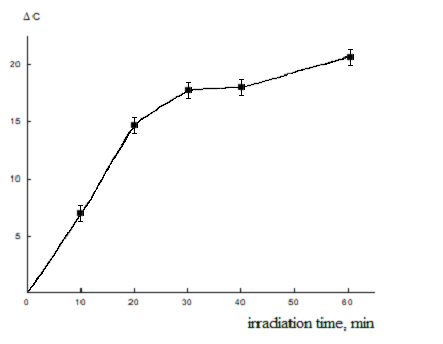
Figure 10 - Dependence of water passage rate through cell membranes DC on irradiation time for wheat seeds of "Ivolga" variety
5. Conclusions
Under the action of a magnetic field, the permeability of cell membranes increases, which accelerates the diffusion of molecules and ions through the membrane. As a consequence, the concentration of substances in cells changes, which leads to an increase or slowdown in the rate of chemical reactions depending on the water content of the plant cell. The rate of change of substance concentration depends on irradiation time.
